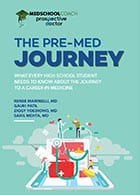
Table of Contents
Several types of residency options are available in the U.S. through the National Resident Matching Program (NRMP). These generally fall into four categories: categorical, preliminary, transitional, and advanced types.
International medical graduates (known as IMGs) may be even less familiar with the intricacies of U.S. physician training pathways.
Keep reading to learn about the different types of residencies and which one is right for your unique post-graduate medical education journey.
Categorical
Categorical positions are what most U.S. medical students are looking to match into for residency training during their final year in medical school. A categorical position offers full residency training required for board certification in a particular specialty.
Categorical programs offer the full training necessary to acquire board certification in that particular discipline. Popular examples of typically categorical residencies:
- Cardiology
- Emergency medicine
- Family medicine
- Internal medicine
- Neurology
- Neurosurgery
- Obstetrics and gynecology (OB/GYN)
- Pediatrics
- Psychiatry
Read More: Least Stressful Specialties
Preliminary
A preliminary residency (prelim) is usually one year of training prior to entry into an advanced specialty program. Some internal medicine and general surgery training programs offer prelim positions in addition to categorical positions at the same institution.
Students only need a prelim intern year if they’re aiming for an advanced PGY-2 residency thereafter. If you’re applying to a categorical position, the PGY-1 intern year is built in, so there’s no need to apply to preliminary training.
Read Next: Residency Salary
Also note that a transitional year typically falls under the umbrella term “preliminary position.” However, where the NRMP Match is concerned, prelim positions and transitional positions are distinct categories.
Transitional Year Programs
Transitional year programs are a subtype of preliminary programs that offer a broad-based clinical experience across internal medicine, surgery, and elective specialties. Transitional programs provide a “sampling” of multiple disciplines, but the exact rotations vary by program.
They’re often used by residents entering specialties that require a separate PGY-1 year as a prerequisite.
Learn More: Should You Send Letters of Intent to Residencies?
Transitional year programs fall under the umbrella of preliminary year training programs, which are stepping stones to categorical positions. The term “transitional year” typically refers to broader training, whereas “prelim year” typically refers to focusing on a single subject.
Advanced (PGY-2)
Advanced residencies are residencies in non-categorical programs after completing an intern year. Many specialty programs require students to apply to a prelim year and a PGY-2 program one year in advance; so, those PGY-2 programs are called “advanced.”
Applicants apply for both their intern year and advanced training simultaneously, but separately. As a result, the application fees and interview trail costs will likely double.
Related: A Guide to Residency Program Signaling (Should You Use Them?)
Advanced (PGY-2) positions are often for the most competitive fields, such as:
- Anesthesiology
- Dermatology
- Ophthalmology
- Plastic surgery
- Physical medicine
- Radiology
- Radiation oncology
- Urology
If a student is applying to an advanced program and doesn’t match, they may still be able to match into a prelim year program. They can aim to impress the faculty there and move to a categorical program the year after.
You may also consider reapplying to a PGY-2 position in the next residency application cycle. This is risky for multiple reasons. You have no guarantee of matching, and there are fewer off-cycle PGY-2 spots than those reserved for applicants applying a year in advance.
How to Apply to Residency Positions
Here’s a brief breakdown how to apply to residency positions:
- Sign in to and get familiar with MyERAS, the service through which you’ll apply to residencies.
- Make sure you’ve taken USMLE Step 2 CK and gotten a good score.
- Determine 1-2 specialties you want to apply for, as well as your application’s competitiveness.
- Use guides and qualified application counselors to help you fill out the complex application sections, such as Personal Statement and Selected Experiences. Obtain letters of recommendation with plenty of time to spare.
- Submit applications by the deadline at the beginning of September, typically at the beginning of your senior year in med school. Read here for more information about how many programs you should apply to.
- Prepare for interviews. Complete mock interviews, prepare for the proper format, know your CV, and learn how to answer questions with confidence.
- After interviews, plan to rank your residencies with the National Resident Matching Program (NRMP). They have you make a rank order list (ROL), which tells their algorithm which programs you’d most like to be matched with. Residencies create similar ROLs but for the students they’d most like to be matched with.
- Match Week is in March. At the start of the week, you learn if you matched or not. If you didn’t, you have a few days of Supplemental Offer and Acceptance Program (SOAP) to interview over the phone for open residency positions. By the end of the week, you’ll know if you’ve matched and where you’re going in the fall.
Remember to start early and don’t let yourself get stressed out about deadlines.
FAQs
Depending on your specialty, you can definitely apply to categorical, prelim, transitional, and advanced programs all in the same ERAS cycle. In fact, we recommend you apply to multiple types of residencies.
If you didn’t match into an advanced program but you did match into a prelim intern year (including via SOAP at the end of Match Week), you should still complete your PGY-1 residency. You just won’t have anything lined up for PGY-2. Reapply for a PGY-2 next cycle or switch paths to a categorical position in the next year.
If you didn’t match into a PGY-2 or a PGY-1 prelim program, hopefully during Match Week, you can use the Supplemental Offer and Acceptance Program (SOAP) to snag an empty spot at a categorical residency that interests you. If SOAP doesn’t work out, you can take a gap year to improve your application strength.
here are certain specialties that IMGs tend to find easier to match for positions (namely internal medicine, family medicine, and pediatrics). If you’re an international medical graduate applying for residency, it’s typically easiest to qualify for categorical positions in one of these specialties.
Preliminary and advanced positions in any specialty are typically more difficult for IMGs to qualify for, in some cases, because they are frequently for less IMG-friendly specialties. There are also additional concerns around visas and overall stability that make dual-applying to preliminary and advanced positions a headache. Still, it’s possible to qualify for any residency position as an IMG with the appropriate credentials.
Get Personalized Residency Match Support
Most applications for residency positions are transmitted by using the AAMC’s Electronic Residency Application Service (ERAS). Visit the ERAS website for information about the application process. Visit the NRMP website for more info about ranking and matching.
You can do this on your own or use application counseling to boost your chances of success. Our Physician Advisors at MedSchoolCoach have been through this process and helped hundreds of students like you match into the residency of their dreams.

Amar Mandalia, MD
Dr. Mandalia is an accomplished medical writer with multiple manuscripts in peer-reviewed journals and a practicing GI physician in the Orlando area. He is the Admissions Advisor for MedSchoolCoach and has extensive experience helping students get into medical school and residency.





